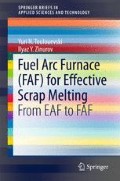Abstract
In modern EAFs electrical energy consumption is on the average about 375 kWh per ton of liquid steel. Such high electrical energy consumptions cannot be justified as EAFs have great potentials of a deep substitution of much cheaper and affordable energy of natural gas for electrical energy. The entire heat in an EAF can be divided into three stages: the heating of scrap up to an average mass temperature of 1000–1100°; further heating and melting down of scrap; and finally, heating the melt to a tapping temperature. At the typical tapping temperature, the enthalpy of liquid metal amounts to on the average 400 kWh/t; and the enthalpy of scrap at a temperature of 1050 ℃ is about 200 kWh/t. Thus, 50% of the total energy transferred to the scrap and the liquid bath during the process is consumed at the first stage where, unlike the subsequent stages, the use of electrical energy is not absolutely necessary. To heat a scrap to a temperature of close 1000 ℃ it is necessary to use the energy of fuel instead of electrical energy. This would allow reducing electrical energy consumption by a factor of 1.8.
Access this chapter
Tax calculation will be finalised at checkout
Purchases are for personal use only
Notes
- 1.
The global production of these products was 75 million tons in 2013.
- 2.
Electrode consumption is increasing along with electricity consumption.
References
Steel Statistical Yearbook (2016) worldsteel Committee on Economic Studies, Brussel p. 46. http://www.worldsteel.org
Abel M, Hein M (2008) The Simetal Ultimate at Colakoglu, Turkey. In AISTech 2008 Conference. Pittsburgh, Pa., USA
Sellan R, Fabbro M, et al (2008) The 300 t EAF meltshop at the Iskenderun mini-mill complex. MPT Internation (2): 52–58
Mukkhopadhyay A, Coughlan R, et al (2012) An advanced EAF optimization suite for 420-t jumbo DC furnace at Tokyo steel using DANIELI technology. In AISTech Conference, Proceedings, vol 1. pp 745–756
Author information
Authors and Affiliations
Corresponding author
Rights and permissions
Copyright information
© 2017 The Author(s)
About this chapter
Cite this chapter
Toulouevski, Y.N., Zinurov, I.Y. (2017). EAF in Global Steel Production; Energy and Productivity Problems. In: Fuel Arc Furnace (FAF) for Effective Scrap Melting. SpringerBriefs in Applied Sciences and Technology. Springer, Singapore. https://doi.org/10.1007/978-981-10-5885-1_1
Download citation
DOI: https://doi.org/10.1007/978-981-10-5885-1_1
Published:
Publisher Name: Springer, Singapore
Print ISBN: 978-981-10-5884-4
Online ISBN: 978-981-10-5885-1
eBook Packages: Chemistry and Materials ScienceChemistry and Material Science (R0)

